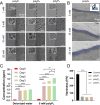Influence of Polyphosphate on the Mineralization Balance of Tooth Enamel
- PMID: 40124016
- PMCID: PMC11923674
- DOI: 10.1021/acsomega.4c09093
Influence of Polyphosphate on the Mineralization Balance of Tooth Enamel
Abstract
Dental minerals are in an equilibrium state of demineralization and remineralization, which can be disrupted by pathogenic bacteria to cause dental caries. While the inorganic polymer polyphosphate (polyP) is ubiquitous in living organisms and is also widely involved in mineralization regulations, its specific influence on the mineralization balance of teeth remains unclear. As a concept-and-proof study, the effects of polyP on the demineralization and remineralization of teeth are investigated on dental enamel (the highly mineralized outer covering tissue of teeth) from the perspective of mineralization balance. We found that a high concentration (containing 1.0-20 mM P element, comparable to and higher than the free phosphate ions in body fluids) of polyP has the capability to demineralize enamel in the aqueous solution, yet this effect is absent in the simulated biological environments including simulated body fluid and MEM (α-minimum essential medium) solutions. More importantly, polyP with a very low concentration (containing ≥5.0 μM P) is able to inhibit enamel mineralization significantly. This suggests that polyP could impact the mineralization balance of enamel by preferentially inhibiting the remineralization process, thereby disrupting the equilibrium necessary for maintaining enamel health.
© 2025 The Authors. Published by American Chemical Society.
Conflict of interest statement
The authors declare no competing financial interest.
Figures







References
-
- Signorini L.; Ballini A.; Arrigoni R.; De Leonardis F.; Saini R.; Cantore S.; De Vito D.; Coscia M. F.; Dipalma G.; Santacroce L.; et al. Evaluation of a Nutraceutical Product with Probiotics, Vitamin D, Plus Banaba Leaf Extracts (Lagerstroemia speciosa) in Glycemic Control. Endocr. Metab. Immune Disord.: Drug Targets 2021, 21, 1356.10.2174/1871530320666201109115415. - DOI - PubMed
LinkOut - more resources
Full Text Sources
Research Materials
